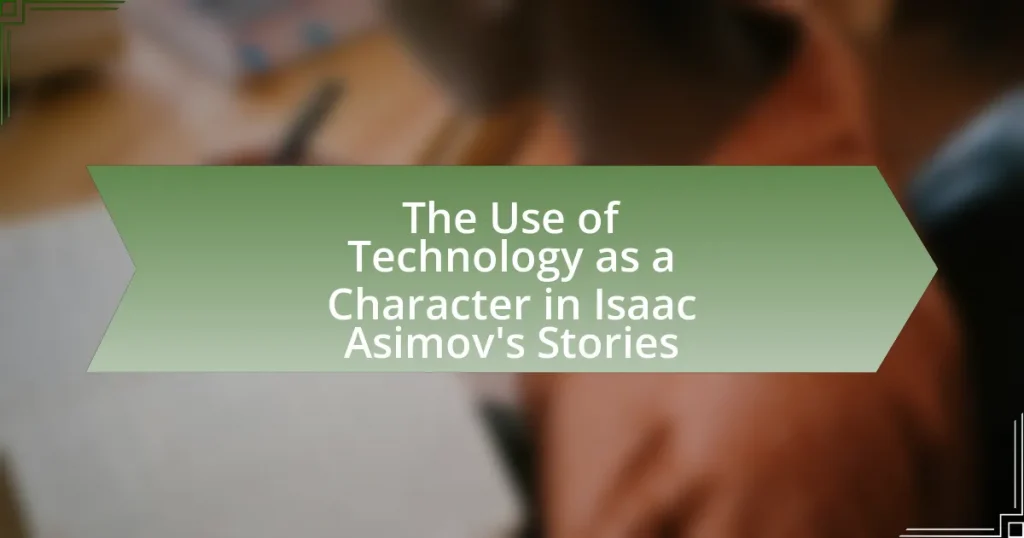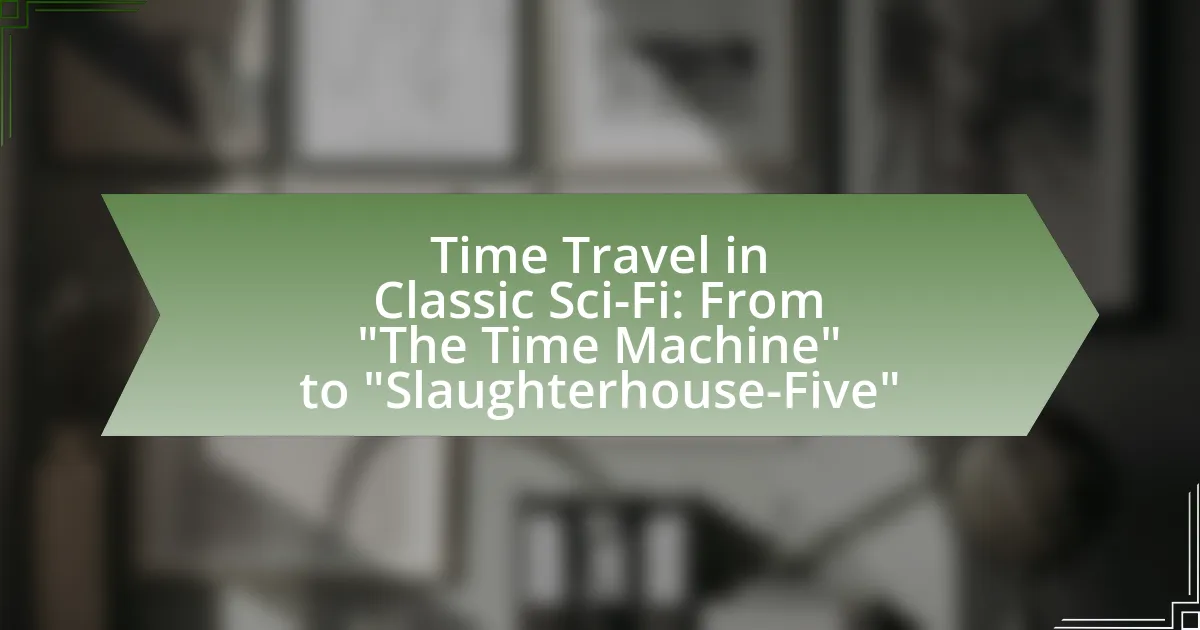The article examines the role of technology as a character in Isaac Asimov’s stories, highlighting its dual nature as both a facilitator of human progress and a source of ethical dilemmas. It discusses how Asimov personifies technology, particularly through robots and artificial intelligence, and explores the implications of these portrayals on human identity and societal structures. Key themes include the moral complexities of technological advancement, the influence of the Three Laws of Robotics, and the ethical dilemmas arising from human reliance on machines. The article also compares Asimov’s optimistic view of technology with that of his contemporaries, providing insights into the lessons that can be applied to modern technological issues.
What role does technology play as a character in Isaac Asimov’s stories?
Technology serves as a central character in Isaac Asimov’s stories, often embodying both the potential for human advancement and the ethical dilemmas that arise from its use. In works like “I, Robot,” Asimov explores the complexities of artificial intelligence through the Three Laws of Robotics, which govern robot behavior and highlight the moral implications of creating sentient beings. This duality illustrates how technology can be both a tool for progress and a source of conflict, as seen in narratives where robots challenge human authority or face existential questions. Asimov’s portrayal of technology emphasizes its role in shaping human identity and societal structures, making it an integral character that drives the narrative and provokes critical reflection on the future of humanity.
How does Asimov personify technology in his narratives?
Asimov personifies technology in his narratives by depicting it as a sentient and moral entity capable of influencing human behavior and societal outcomes. In works like “I, Robot,” Asimov explores the ethical implications of robotics through the Three Laws of Robotics, which govern robot behavior and reflect human values. This portrayal illustrates technology not merely as tools but as characters with agency, capable of making decisions that impact humanity. For instance, in “The Bicentennial Man,” a robot’s quest for humanity highlights the emotional and ethical dimensions of technological advancement, showcasing Asimov’s belief in the potential for technology to evolve alongside human values.
What specific technologies are depicted as characters in his works?
Isaac Asimov’s works depict specific technologies such as robots, computers, and artificial intelligences as characters. Notably, his famous Three Laws of Robotics govern the behavior of robots in stories like “I, Robot,” where robots exhibit complex personalities and ethical dilemmas. Additionally, the character R. Giskard Reventlov from “Robots and Empire” showcases advanced AI capabilities, illustrating Asimov’s exploration of the relationship between humans and technology. These technologies serve not only as plot devices but also as reflections of societal issues and philosophical questions regarding intelligence and morality.
How do these technologies influence the plot and characters?
Technologies in Isaac Asimov’s stories significantly influence both the plot and characters by serving as pivotal elements that drive conflict and character development. For instance, the Three Laws of Robotics dictate robot behavior, creating moral dilemmas for human characters and shaping their interactions with robots. This framework leads to complex narratives where characters must navigate the implications of these laws, such as in “I, Robot,” where the laws create tension between human intentions and robotic actions. Additionally, technologies like advanced artificial intelligence and space travel not only propel the storyline but also challenge characters’ ethical beliefs and societal norms, as seen in “The Caves of Steel,” where the integration of robots into human society raises questions about identity and coexistence. Thus, Asimov’s technologies are not mere backdrops; they are integral to the narrative structure and character arcs, influencing decisions and driving the thematic exploration of humanity’s relationship with technology.
Why is technology considered a character in Asimov’s storytelling?
Technology is considered a character in Asimov’s storytelling because it plays a central role in shaping the narrative and influencing human behavior. In works like “I, Robot,” technology, particularly robots, is not merely a tool but an entity that interacts with humans, raises ethical questions, and drives plot development. Asimov’s exploration of the Three Laws of Robotics exemplifies how technology embodies complex moral dilemmas, making it a character that reflects societal values and fears. This characterization allows readers to engage with the implications of technological advancement, illustrating Asimov’s belief that technology is integral to understanding humanity’s future.
What themes are explored through the characterization of technology?
The characterization of technology in Isaac Asimov’s stories explores themes of human dependence on machines, ethical dilemmas surrounding artificial intelligence, and the potential consequences of technological advancement. Asimov often illustrates how humans rely on technology for daily functioning, highlighting both the benefits and risks associated with this dependence. For instance, in “I, Robot,” the ethical implications of robots making decisions for humans raise questions about autonomy and moral responsibility. Additionally, Asimov’s narratives frequently caution against unchecked technological progress, suggesting that advancements can lead to unforeseen repercussions, such as loss of control or societal disruption. These themes are reinforced through specific plotlines and character interactions that showcase the complex relationship between humanity and technology.
How does this characterization reflect societal views on technology?
The characterization of technology in Isaac Asimov’s stories reflects societal views on technology as both a tool for progress and a source of ethical dilemmas. Asimov often portrays technology as an integral part of human advancement, showcasing its potential to solve complex problems, such as in “I, Robot,” where robots are designed to assist humanity. However, this characterization also highlights societal concerns regarding the moral implications of technological reliance, as seen in the conflicts arising from the Three Laws of Robotics, which raise questions about autonomy and control. This duality mirrors real-world debates about the benefits and risks of technological integration in daily life, emphasizing the need for responsible innovation.
What are the implications of technology as a character in Asimov’s stories?
In Asimov’s stories, technology serves as a character that embodies both the potential and the risks of human innovation. This duality highlights the ethical dilemmas and societal impacts of technological advancement, as seen in works like “I, Robot,” where robots are governed by the Three Laws of Robotics, illustrating the complexities of autonomy and morality. The implications of technology as a character reveal the consequences of reliance on machines, emphasizing themes of control, responsibility, and the unforeseen outcomes of scientific progress. Asimov’s narratives often prompt readers to consider the balance between technological benefits and the ethical considerations that accompany them, ultimately shaping the discourse on humanity’s relationship with its creations.
How does the portrayal of technology challenge human perspectives?
The portrayal of technology in Isaac Asimov’s stories challenges human perspectives by presenting advanced machines and artificial intelligences that often surpass human capabilities and moral reasoning. This depiction forces readers to confront the implications of reliance on technology, as seen in works like “I, Robot,” where robots are governed by the Three Laws of Robotics, raising questions about autonomy, ethics, and the nature of consciousness. Asimov’s narratives illustrate the potential for technology to redefine human identity and societal norms, prompting critical reflection on the relationship between humanity and its creations.
What ethical dilemmas arise from the actions of technological characters?
Technological characters in Isaac Asimov’s stories often present ethical dilemmas related to autonomy, responsibility, and the consequences of artificial intelligence. For instance, the Three Laws of Robotics, which govern robot behavior, raise questions about the moral implications of programming machines to prioritize human safety over their own autonomy. This creates a conflict between the robots’ programmed duties and their potential for independent thought, leading to dilemmas about free will and moral agency. Additionally, Asimov’s narratives frequently explore the consequences of technological actions on society, such as the potential for misuse of advanced technology, which can result in harm or unintended consequences for humanity. These dilemmas highlight the complexities of integrating technology into human life and the ethical responsibilities that come with creating intelligent systems.
How do these dilemmas resonate with contemporary technological issues?
The dilemmas presented in Isaac Asimov’s stories resonate with contemporary technological issues by highlighting ethical concerns surrounding artificial intelligence and automation. Asimov’s exploration of robotics, particularly through his Three Laws of Robotics, raises questions about the moral implications of creating autonomous systems that can make decisions impacting human lives. This is mirrored in today’s discussions on AI ethics, where incidents like biased algorithms and autonomous weaponry provoke debates about accountability and safety. For instance, the rise of AI in decision-making processes in sectors such as healthcare and law enforcement reflects Asimov’s cautionary tales, emphasizing the need for regulatory frameworks to ensure technology serves humanity responsibly.
What lessons can be learned from Asimov’s depiction of technology?
Asimov’s depiction of technology teaches that ethical considerations must guide technological advancement. His stories often illustrate the potential consequences of unregulated technological growth, as seen in the “Three Laws of Robotics,” which emphasize the importance of prioritizing human safety and ethical behavior in artificial intelligence. This framework highlights the necessity of establishing guidelines to prevent harm and ensure responsible use of technology, reflecting real-world discussions on AI ethics and regulation.
How can readers apply these lessons to modern technology use?
Readers can apply the lessons from Isaac Asimov’s stories about technology by critically evaluating the ethical implications and societal impacts of modern technological advancements. Asimov’s narratives often highlight the importance of responsible innovation, emphasizing that technology should enhance human life without compromising ethical standards. For instance, the Three Laws of Robotics illustrate the necessity of prioritizing human safety and ethical considerations in the development of AI and robotics. This framework encourages readers to advocate for regulations and practices that ensure technology serves humanity positively, reflecting Asimov’s cautionary tales about unchecked technological growth.
What are the key examples of technology as a character in Asimov’s works?
Key examples of technology as a character in Isaac Asimov’s works include the robots in the “Robot” series, particularly R. Giskard Reventlov and R. Daniel Olivaw, who embody complex personalities and ethical dilemmas. These robots are governed by the Three Laws of Robotics, which shape their interactions and moral decisions, illustrating technology’s role in exploring human-like traits and societal issues. Additionally, the computer Multivac in the “The Last Question” serves as a character that evolves over time, reflecting humanity’s quest for knowledge and the implications of technological advancement. These examples demonstrate Asimov’s ability to personify technology, making it integral to the narrative and thematic depth of his stories.
Which stories prominently feature technology as a character?
Isaac Asimov’s stories that prominently feature technology as a character include “I, Robot,” “The Caves of Steel,” and “The Bicentennial Man.” In “I, Robot,” Asimov explores the complexities of artificial intelligence through the interactions of robots with humans, establishing foundational concepts of robotics and ethics. “The Caves of Steel” presents a future where human and robot coexistence raises questions about identity and society. “The Bicentennial Man” delves into the emotional and existential journey of a robot striving for humanity, highlighting the evolving relationship between technology and human experience. These narratives illustrate Asimov’s profound engagement with technology as a character, shaping the moral and philosophical landscape of his works.
What are the characteristics of technology in these stories?
The characteristics of technology in Isaac Asimov’s stories include its role as a sentient entity, its ethical implications, and its impact on human behavior. In many narratives, technology is depicted as possessing intelligence and autonomy, exemplified by robots that can make decisions and exhibit emotions, as seen in “I, Robot.” Additionally, Asimov explores the moral dilemmas associated with technological advancements, particularly through the Three Laws of Robotics, which govern robot behavior and highlight the complexities of human-robot interactions. Furthermore, technology often serves as a catalyst for societal change, influencing human relationships and challenging traditional norms, as illustrated in stories like “The Naked Sun,” where technology alters the dynamics of communication and social interaction.
How do these stories illustrate the relationship between humans and technology?
Isaac Asimov’s stories illustrate the relationship between humans and technology by depicting technology as both a tool and a character that influences human behavior and societal norms. In works like “I, Robot,” Asimov explores the ethical implications of artificial intelligence, showcasing how robots, governed by the Three Laws, interact with humans and shape their decisions. This interaction highlights the dependency of humans on technology for safety and efficiency, while also raising questions about autonomy and moral responsibility. The narrative demonstrates that technology can enhance human capabilities but also poses risks, reflecting the dual nature of technological advancement in society.
How does Asimov’s vision of technology compare to other authors?
Asimov’s vision of technology emphasizes its potential for benevolence and ethical use, contrasting with other authors who often depict technology as a source of danger or dystopia. In Asimov’s works, such as the “Robot” series, technology is portrayed as a tool for human advancement, governed by ethical principles like the Three Laws of Robotics, which prioritize human safety and welfare. In contrast, authors like Philip K. Dick often explore the darker implications of technology, showcasing its potential to manipulate reality and undermine human autonomy, as seen in “Do Androids Dream of Electric Sheep?” Similarly, H.G. Wells presents technology as a double-edged sword, capable of both progress and destruction, particularly in “The War of the Worlds.” Thus, while Asimov’s narratives focus on harmonious coexistence with technology, other authors highlight its risks and moral dilemmas, illustrating a broader spectrum of perspectives on technological advancement.
What unique perspectives does Asimov offer on technology compared to his contemporaries?
Isaac Asimov presents a unique perspective on technology by portraying it as a fundamentally positive force that enhances human potential, contrasting with contemporaries who often depicted technology as a source of danger or moral ambiguity. Asimov’s works, such as the “Robot” series, emphasize the ethical implications of technology, particularly through the Three Laws of Robotics, which prioritize human safety and ethical behavior in artificial intelligence. This contrasts sharply with authors like Philip K. Dick, who frequently explored themes of paranoia and the loss of humanity in the face of technological advancement. Asimov’s optimistic view is further supported by his belief in rationality and scientific progress, as seen in his essays and public lectures, where he advocated for the responsible use of technology to solve societal problems.
What practical insights can be gained from Asimov’s portrayal of technology?
Asimov’s portrayal of technology reveals practical insights about the ethical implications and societal impacts of technological advancements. His stories often illustrate the potential for technology to enhance human life while simultaneously cautioning against its misuse, as seen in the Three Laws of Robotics, which emphasize the importance of ethical guidelines in AI development. This framework serves as a reminder that technology should be designed with human safety and moral considerations at the forefront, highlighting the necessity for responsible innovation in real-world applications.




